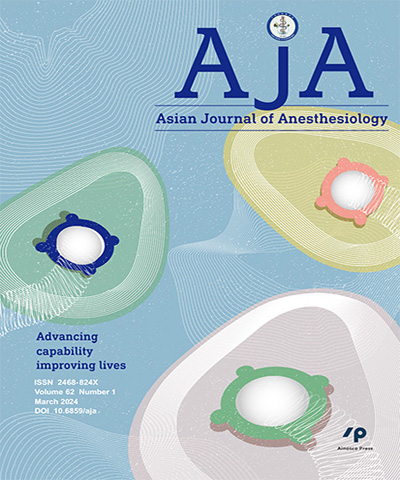
Asian Journal of Anesthesiology
- OpenAccess
- Ahead-of-Print
台灣麻醉醫學會 & Ainosco Press,正常發行
選擇卷期
- 期刊
- OpenAccess
- Ahead-of-Print
- 期刊
- OpenAccess
- Ahead-of-Print
- 期刊
- OpenAccess
- Ahead-of-Print
- 期刊
- OpenAccess
- Ahead-of-Print
- 期刊
- OpenAccess
- Ahead-of-Print
- 期刊
- OpenAccess
- Ahead-of-Print
Background: Reducing anesthesia-controlled time (ACT) such as extubation time may improve operation room (OR) efficiency result from different anesthetic techniques. However, the information about the difference in ACT between desflurane (DES) anesthesia and propofol-based total intravenous anesthesia (TIVA) techniques for open liver resection under general anesthesia is not available in the literature. Methods: This retrospective study uses our hospital database to analyze the ACT of open liver resection after either DES/fentanyl-based anesthesia or TIVA via target-controlled infusion with fentanyl/propofol from January 2010 to December 2011. The various time intervals including waiting for anesthesia time, anesthesia time, surgical time, extubation time, exit from OR after extubation, total OR time, and post-anesthetic care unit stay time and percentage of prolonged extubation (≥ 15 minutes) were compared between the two anesthetic techniques. Results: We included 143 hepatocellular carcinoma patients, with 82 patients receiving TIVA and 61 patients receiving DES. The extubation time was faster (10.1 ± 3.2 min vs. 11.8 ± 5.2 min; P = 0.03), and the incidence of prolonged extubation was lower (9.8% vs. 26.8%; P = 0.02) in the DES group than in the TIVA group. The factors contributed to prolonged extubation were age, sex, anesthetic technique, and anesthesia time. Conclusions: The DES anesthesia provided faster extubation time and lower incidence of prolonged extubation compared with propofol-based TIVA by target-controlled infusion in elective open liver resection. Besides, older age, male, TIVA, and lengthy anesthesia time were factors affecting prolonged extubation.
- 期刊
- OpenAccess
- Ahead-of-Print
Background: Extended-release local anesthetics allow for prolonged analgesia after a single administration. Although Asians demonstrate different pain thresholds than Caucasians, whether they have different postoperative local anesthetic analgesic effects has not been elucidated. Objective: We aimed to compare the postoperative analgesic efficacy of liposomal bupivacaine on Asian and Caucasian adults, and the incidence of local anesthetic systemic toxicity (LAST) syndrome. Methods: We conducted a retrospective, assessor-blinded cohort study of adult patients who received liposomal bupivacaine for surgery between 2012 and 2018. Asians and Caucasians were matched in a 1:1 ratio by clinical characteristics and surgery type. The primary outcome was pain management, defined as average pain score and opioid consumption during the initial 72 postoperative hours. The secondary outcome was the incidence of LAST syndrome. Reviewers were blinded to the ethnicity of the patient. Results: After 1:1 propensity score matching, 130 Asians and 129 Caucasians were analyzed. All confounding variables were balanced, except for higher body mass index in the Asian group. Pain scores were lower (adjusted mean difference of -0.50 [97.5% CI, -0.98, -0.01]; superiority p = 0.011) and opioid consumption was not greater (geometric means ratio, 0.61 [97.5% CI, 0.36, 1.04]; non-inferiority p < 0.001) in Asian patients compared to Caucasian patients. Only one Caucasian patient was judged as having a potential case of LAST syndrome. The length of hospital stay and the incidence of additional complications were not different between the groups. Conclusion: Asian adults receiving liposomal bupivacaine as part of multimodal perioperative analgesia demonstrated lower pain scores compared to matching Caucasians, despite not having greater opioid consumption.
- 期刊
- OpenAccess
- Ahead-of-Print
- 期刊
- OpenAccess
- Ahead-of-Print
- 期刊
- OpenAccess
- Ahead-of-Print

